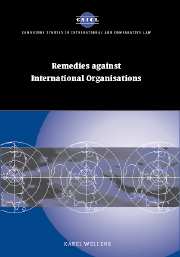Book contents
- Frontmatter
- Contents
- Acknowledgements
- List of abbreviations
- Introduction
- Part I General features of remedies against international organisations
- 1 The accountability regime for international organisations
- 2 Remedies against international organisations
- 3 The different levels of accountability and the appropriateness of various remedies: scope ratione materiae
- 4 Access to remedies
- 5 Remedies against whom: the scope ratione personae respondentis
- 6 The potential outcome of remedies: scope ratione remedii
- Part II Procedural aspects of remedial action against international organisations
- Part III Substantive outcome of remedial action against international organisations
- Part IV Alternative remedial action against international organisations and options for the future
- Conclusion
- Bibliography
- Index
- CAMBRIDGE STUDIES IN INTERNATIONAL AND COMPARATIVE LAW
2 - Remedies against international organisations
Published online by Cambridge University Press: 13 July 2009
- Frontmatter
- Contents
- Acknowledgements
- List of abbreviations
- Introduction
- Part I General features of remedies against international organisations
- 1 The accountability regime for international organisations
- 2 Remedies against international organisations
- 3 The different levels of accountability and the appropriateness of various remedies: scope ratione materiae
- 4 Access to remedies
- 5 Remedies against whom: the scope ratione personae respondentis
- 6 The potential outcome of remedies: scope ratione remedii
- Part II Procedural aspects of remedial action against international organisations
- Part III Substantive outcome of remedial action against international organisations
- Part IV Alternative remedial action against international organisations and options for the future
- Conclusion
- Bibliography
- Index
- CAMBRIDGE STUDIES IN INTERNATIONAL AND COMPARATIVE LAW
Summary
Remedies in international law
Limiting ourselves for a moment to the international legal context within which states, international organisations, non-governmental organisations and individuals are operating, some observations have to be made regarding remedies in international law.
It was commonly understood, sometimes tacitly, that doctrinal writings were neglecting (admittedly to varying degrees) the issue of remedies. Christine Gray was right when she observed, back in 1987, that the question of judicial remedies had generally been regarded as peripheral to the main study of international law; attention had been centred on the substantive rules with little consideration given to the consequences of their violation in general or judicial remedies in particular. The remedies are something to be invented anew in each case. In addition, partly because the statutes of international administrative tribunals govern the appropriate remedies for injuries to officials, these tribunals ‘in their generally rather summary discussion of remedies’ did not make any substantial theoretical contribution to the general international law on remedies.
Since 1987 not only has the International Law Commission made substantial progress in its work on the draft on state responsibility, but the problem of remedies, not merely the judicial ones, has become the focus of attention, spreading over a wide range of different branches of international law. The creation of the new dispute settlement mechanism within the World Trade Organisation has led to an unprecedented flow of studies on remedies in international trade law.
- Type
- Chapter
- Information
- Remedies against International Organisations , pp. 10 - 27Publisher: Cambridge University PressPrint publication year: 2002



